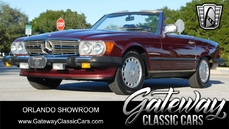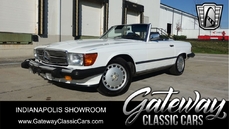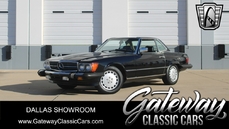Mercedes-Benz 560SL w107 Convertible 1987
General description :
The perennial Mercedes-Benz R107 series is one of the most iconic luxury cars of the 70s and 80s. In movies and television, the SL roadster was often the car seen cruising Rodeo Drive or through Miami Beach. It was a car that defined the marque and the era. Such was its enduring charm; it is surprising to recall the car was first introduced back in 1971. Known internally and by loyal fans as the R107 (the four seat SLC was dubbed C107), the car was designed in house at Sindelfingen by Karl Wilfert and his team. The styling was understated but elegant yet highly sophisticated. Mercedes-Benz’s obsession with occupant and pedestrian safety through the 1960s led to a great number of subtle yet important design features that would trickle down to the rest of the line during the coming two decades. The SL roadster spoke to a new breed of luxury roadster buyers and went on to become the longest-running production passenger car in Mercedes’ history. Mechanically, the R107 took a page from its predecessors, riding on a unique platform but sharing engines and suspension components with its sedan counterparts. It was also incredibly well-built, with a solidity and over-engineered feeling that few manufacturers past or present could match. Through the years of production, Mercedes continually refined the formula, adding ever increasing displacement V8 engines, improved materials and refined design.
The ultimate model in the R107 SL range is the 560SL. The big 5.6 liter V8 from the S-Class was shoehorned into the SL’s engine bay to create a sporting car that was capable of 150mph performance while remaining quiet, composed and sophisticated. It was the sports car for those who preferred not be ruffled when arriving at the club in style.
This 1987 560SL is a desirable later production example, finished in rarely seen and elegant colors of Diamond Blue (3550) over cream beige leather and a dark blue top. It is a highly original and very well maintained example that has covered a scant 31,261 miles over the past 30 years. The body is very straight and crisp, with no corrosion and factory precise panel gaps. A clean Carfax report shows no known history of accident damage, and continuous ownership for the past 17 years. The paint quality is excellent, showing only a few very minor touch ups. Bumpers are excellent, with original chrome plating and very good original extensions and rubber trim. Original Bosch fog lamps are fitted to the front bumper, and all other lights and lenses are excellent with no cracks or chips. Original Sekurit glass is in fine order, including on the removable hard top. A subtle cream double coach stripe ties the color scheme together. Wheels are factory original disc-style wrapped in very good Pirelli rubber. The wheels are in excellent condition, the correct bright silver finish showing virtually no pitting and no signs of curb rash.
Doors open with that signature Mercedes-Benz solidity to reveal an outstanding and lovely interior. Beige leather (code 275) is clean and very tidy with no rips, tears or undue wear, beautifully complementing the Diamond Blue paint. Only the slightest bit of wear can be found on the driver’s outer bolster upon close inspection. Carpets and overmats are excellent as is the headlining on the hard top. The original Becker Grand Prix cassette player remains in place. Original wood trim presents very well on the excellent dash, with only a slight crack forming in the lacquer on the center console wood, which does little to detract from the otherwise excellent interior. Blue German canvas soft top is in very good order as well and functions as it should.
The chassis and engine bay exhibit factory original surfaces, accessories and hardware which are in appropriate condition for such an exceedingly well-maintained and low-mileage example. Original books and some service records are included, as are the original hard-top removal tools and a hard top storage stand.
The big 5.6 liter V8 runs strong, with plenty of low end torque, and smooth effortless running around town. With the hard top in place, the 560SL becomes a silent, unflustered Grand Touring car, while folding the soft top transforms it into a thrilling open sports car. The 560SL is among the best performing of the R107 breed, with excellent, stable handling and mile-crushing highway ability all wrapped in a timeless and refined body style. As such, values and demand for exceptional examples such as this one have been steadily increasing. This is a beautifully presented, well maintained and low-mileage 560SL in gorgeous colors that will surely satisfy the most meticulous enthusiast.
https://hymanltd.com/vehicles/5947-1987-mercedes-benz-560sl-convertible/
1987 Mercedes-Benz 560SL w107 Convertible is listed sold on ClassicDigest in St. Louis by Mark Hyman for $48500.
Car Facts
Car type : Car Make : Mercedes-Benz Model : 560SL w107 Model Version : Convertible Engine size : 0.0 Model Year : 1987 Sub type : Convertible Location : Missouri
Sold
Seller Information
Sold
People who viewed this Mercedes-Benz 560SL w107 also viewed similar Mercedes-Benz listed at ClassicDigest
Other cars listed for sale by this dealer
About Mercedes-Benz
In the annals of automotive history, the journey of Mercedes-Benz is a tale that unfolds with the ingenuity of its founding pioneers. In the year 1886, Karl Benz crafted the Benz Patent Motorwagen, a creation that would go down in history as the world's inaugural automobile. Unbeknownst to him, this moment marked the genesis of what would evolve into the most illustrious premium car manufacturer globally. The financial underpinning of this pioneering venture, interestingly, was provided by Karl Benz's wife, Bertha Benz, demonstrating a remarkable partnership that would set the tone for Mercedes-Benz's legacy.A parallel narrative emerged not far away, as Daimler-Motoren-Gesellschaft, founded by Gottlieb Daimler and Wilhelm Maybach, entered the scene. In 1901, they unveiled their automobile under the now-famous moniker "Mercedes," meaning "godsend" in Spanish. This name was bestowed upon the car at the behest of Emil Jellinek's daughter, the distributor for Daimler-Motoren-Gesellschaft. The wheels of innovation were set in motion.
Fast forward to 1926, a pivotal year that witnessed the merger of Daimler with Benz & Cie., culminating in the birth of Daimler-Benz. The amalgamation saw the adoption of "Mercedes-Benz" as the distinguished trademark for their automobiles, fusing the legacies of two visionary entities into one.
Contrary to perceptions of conservatism, the trajectory of Daimler-Benz unfolds as a chronicle of industry firsts. From the introduction of the honeycomb radiator to the float carburetor, and the pioneering implementation of four-wheel brakes in 1924, Daimler-Benz consistently pushed the boundaries of automotive innovation. The diesel-powered Mercedes-Benz 260 D in 1936 marked the inception of diesel engines in passenger cars. The iconic Mercedes-Benz 300SL Gullwing made history as the first car with direct fuel injection, albeit the Gutbrod's tiny 2-stroke engine can claim precedence.
Safety innovations became a hallmark, with Béla Barényi's patented safety cell design in the "Ponton"-models in 1951, featuring front and rear crumple zones. The W116 450SEL 6.9 saw the introduction of the Anti-Lock Brake system (ABS), another pioneering safety feature. From the first production airbags and beyond, the legacy of "firsts" continued to be etched into the fabric of Daimler-Benz.
Over its centennial journey, Mercedes-Benz has not merely produced cars but has sculpted automotive icons. The SSKL, 710 SSK Trossi Roadster, 770K Grosser, 540K Spezial Roadster, 300SL Gullwing, w100 600 Pullman, w111 280SE 3.5 Flachkühler, w113 230SL Pagoda, w109 300 SEL 6.3, and w201 2.3-16 Cosworth stand testament to the brand's commitment to engineering excellence.
The roaring Silver Arrows, or "Silberpfeile," including the W 25, W 125, W154, W165, and W196, created a legacy of dominance on the racetrack. These machines were not merely cars; they were expressions of precision, speed, and an indomitable spirit that left their competitors in the dust.
As Mercedes-Benz marches into the future, it does so not just as an automaker but as a custodian of a legacy, a torchbearer of innovation, and a beacon of automotive excellence. The road ahead is sure to witness the continued fusion of cutting-edge technology, timeless design, and an unwavering commitment to setting new standards in the world of automobiles.
One luminary figure who left an indelible mark was Béla Barényi, often heralded as the "father of passive safety" for his pioneering work in safety engineering. His patented safety cell design, featuring front and rear crumple zones, became a hallmark of Mercedes-Benz's commitment to occupant safety, setting new standards that reverberated throughout the automotive world.
Moving through the chronicles, the collaborative genius of Wilhelm Maybach, alongside Gottlieb Daimler, laid the foundation for Daimler-Motoren-Gesellschaft. Their innovations not only birthed the first Mercedes but established a culture of relentless pursuit of technological excellence that remains integral to Mercedes-Benz's DNA.
In the post-merger era of 1926, Ferdinand Porsche emerged as a prominent figure within Mercedes-Benz. His work on the Mercedes-Benz S-Type, a supercharged race car, garnered acclaim and set the stage for a legacy that extended far beyond the marque. Porsche's impact would later extend to his eponymous company, but his influence at Mercedes-Benz during those formative years was pivotal.
As the 20th century progressed, the legendary Rudolf Uhlenhaut emerged as a key figure. Uhlenhaut, an accomplished engineer and the driving force behind the iconic Silver Arrows, played a crucial role in Mercedes-Benz's dominance in motorsports. His engineering prowess and attention to detail were instrumental in creating some of the most formidable racing cars of the era.
In the latter half of the century, figures like Bruno Sacco, the head of design at Mercedes-Benz from 1975 to 1999, left an indelible imprint on the brand's aesthetic identity. Sacco's design philosophy, characterized by clean lines and timeless elegance, shaped iconic models like the W126 S-Class and the W201 190E, solidifying Mercedes-Benz's reputation for luxury and sophistication.
The narrative would be incomplete without acknowledging the contributions of engineers like Hans Scherenberg, whose leadership in the 1970s ushered in a new era of technological innovation at Mercedes-Benz. Scherenberg's tenure saw the development of groundbreaking technologies, including the Anti-Lock Brake system (ABS) and the introduction of airbags in production cars.











